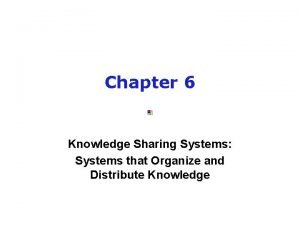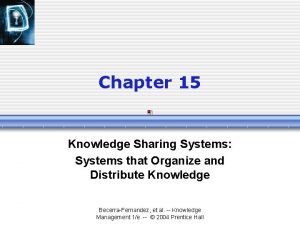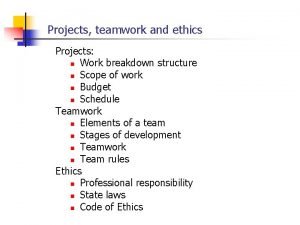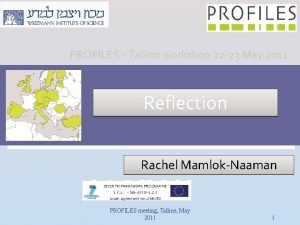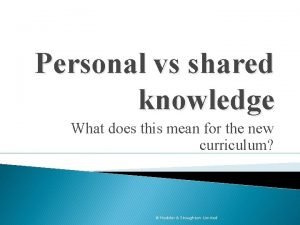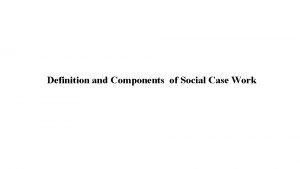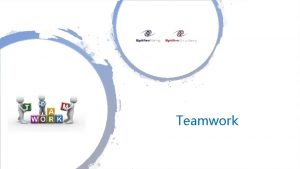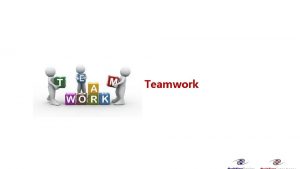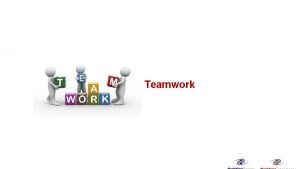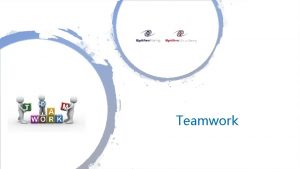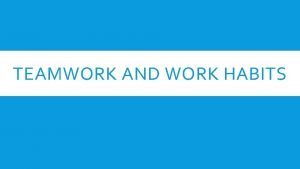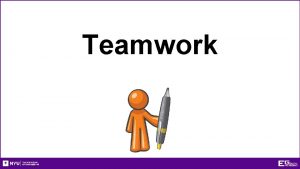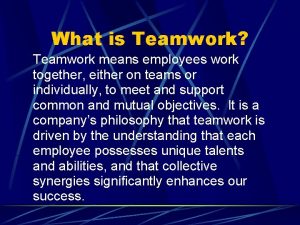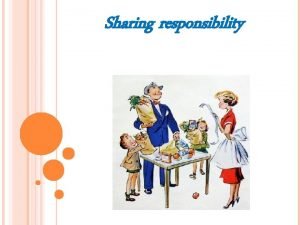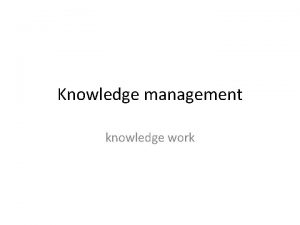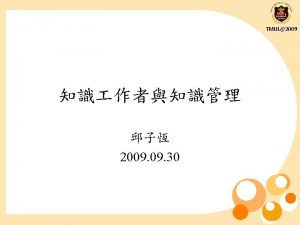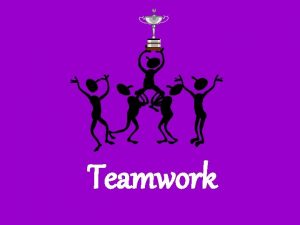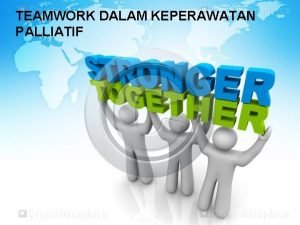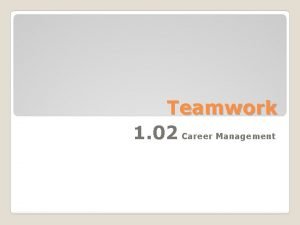Teamwork What is Teamwork Sharing knowledge the work

































































- Slides: 65

Teamwork What is Teamwork ? “Sharing knowledge, the work, the thoughts, the feelings, the excitement, the happiness, the pressure, the pleasure, the emotions, the doubts & the success with each other” 1

Team Composition “A team is a group of people with complementary skills & personalities who feel committed to a shared objective & who need each other in order to achieve results” 2

Effective Teams • Ideal size: 5 -8; max: 12 • Mutual Respect & Understanding • Acceptance & Acknowledgement of cultural differences • Strong Foundation of Trust • Ability to solve problems & internal conflicts effectively • Open Communication • Inspiring Leaders 3

Belbin’s Team Roles – Horizontal Relationships • The personality each team member contributes to the team • Questionnaire to determine which team role each fulfills • Should be equally divided within a team • Team members should be aware of & accept everyone’s team roles 4

Belbin’s 9 Team Roles Role Type Contributions Allowable Weaknesses Plant Creative, Imaginative, Unorthodox Ignores incidentals. Too pre -occupied to communicate effectively Coordinator Mature, confident, a good chairperson. Clarifies goals, promotes decision making, delegates well Can often be seen as manipulative. Offloads personal work Monitor Evaluator Sober, strategic & discerning. Sees all actions; judges accurately Lacks drive & ability to inspire others Implementer Turns ideas into practical manageable actions; logical, methodical Somewhat inflexible. Slow to respond to new possibilities Completer Finisher Painstaking, conscientious, anxious. Searches out errors & omissions. Delivers on time Inclined to worry unduly. Reluctant to delegate 5

Belbin’s 9 Team Roles Role Type Contributions Allowable Weaknesses Resource Investigator Extrovert, enthusiastic, communicative. Explores opportunities, develops contacts, diplomat Over optimistic. Loses interest once initial enthusiasm has passed Shaper Challenging, dynamic, thrives on pressure; has drive & courage to overcome obstacles; brings competitive spirit Prone to provocation, offends people’s feelings Teamworker Cooperative, mild, perceptive & diplomatic; listens, builds & averts friction Indecisive in crunch situations Specialist Contributes only on a narrow front. Dwells on technicalities. Single-minded, self-starting, dedicated. Provides knowledge & skills in rare supply 6

Robert Quinn’s 8 Leadership Roles • Makes continuous improvements possible Flexibility • Has vision of future • Recognizes important trends • Anticipates changes ato to r no va Dir rdin tor ec • Watches over & guides Achievements • Takes care of details & Documentation • Checks if rules are followed • Organizes, coordinates team efforts • Delegates tasks Stability • Pays attention to technological issues Coo • Uses power & influences • Negotiates effectively • Has image, reputation & persuasion Negotiator Producer r • Realizes teamwork • Participatory decision making • Reaches consensus M en • Openness, involvement & to St r im solidarity ula to Internally r Oriented er k c Che In • Develops skills of people • Has a careful, helpful & Systematic approach • Compliments team when due Externally Oriented • Promotes a productive working Environment • Involved & dedicated • Time/Stress Management • Develops policies & rules • Formulates plans • Identifies bottlenecks 7

Culture • “Collective programming of the mind that distinguishes one category of people from another” • “Ways of living - adapted to circumstances”

3 levels of uniqueness in mental programming Inherited and learned (through culture & personal experiences) Specific to Individual Personality Specific to Group or category Universal Culture Learned from social environment Human Nature Inherited (expression ability to feel fear, joy, sadness determined by culture) need for association facility to observe, discuss environment

Manifestations of culture at different levels of depth Values Heroes Symbols Visible Practices Rituals Changes put pressure; sweep the surface but the core remains unchanged

Cultural Manifestations • Symbols: - Words, gestures, objects carrying a particular meaning (dress, flags, status symbols) - Easily developed, changed, copied • Heroes: - People serving as models of behavior (dead or alive, real or imaginary) - Snoopy (US), Asterix (France), Ollie B Bommel (Netherlands)

Cultural Manifestations • Rituals: - Essential collective activities - Religious ceremonies, ways of greeting & paying respect • Values: - Core of Culture - Broad tendencies to prefer certain states of affairs over others: dirty vs clean, dangerous vs safe, natural vs unnatural, forbidden vs permitted

The Learning of Values & Practices Age 0 Family VALUES School 10 PRACTICES 20 Work

Cultural Diversity • Cannot have one aspect of culture that you like without having other aspects that you may not like so much • No culture is objectively better or worse than the other

Cultural Diversity • In the mid 1970's, the Dutch academic, Geert Hofstede, conducted an extensive survey at IBM to investigate the influence of national culture • By filtering out IBM's dominant corporate culture from his data on IBM's national subsidiaries, Hofstede was able to statistically distinguish cultural differences between countries • All cultures meet five basic problems of social life

Hofstede’s classification of a counrty's cultural attitudes in five dimensions Dimension One Extreme Other Extreme Identity Collectivism Individualism Hierarchy Large power distance Small power distance Femininity Masculinity Gender Truth Virtue Strong uncertainty Weak uncertainty avoidance Long term orientation Short term orientation

Five dimensions 1. Identity: relationship between individual & the group Individualism Collectivism Free will is highly valued Adapt to others Individual actions based on selfinterest Individual actions based on interests of group Free Market Government expected to play role in markets Wealthier countries/people take care of themselves Poorer countries / limited resources Loneliness, isolation, anti-social behavior, illusion of group cohesion Repress personal needs

Five dimensions 2. Hierarchy: Degree of inequality between people as assumed to be the natural state of affairs Large power distance Small power distance Preference for hierarchical bureaucracies, strong leaders and a high regard for authority Favor personal responsibility and autonomy Eastern & Southern Europe Northern & Western Europe Easier in poorer countries with limited resources Wealthier countries

Five dimensions 3. Gender: Role equality between genders Femininity Masculinity Equal role distribution Unequal role distribution quality of life; small is beautiful status derived from wages and position Modesty, human relations Assertiveness Netherlands, Scandinavia, Portugal, Costa Rica, Thailand UK, USA, Germany, Switzerland. Austria, Columbia, Japan

Five dimensions 4. Truth: Coping with the unpredictable & ambiguous Strong uncertainty avoidance Weak uncertainty avoidance Fear of the unknown cope better with risk and innovation What is different is dangerous Greater tolerance for differences Individuals require set boundaries, clear rules & structures; self discipline Higher level of standardisation and greater job security Russia, Balkans, Germanic countries, English speaking countries, Japan, Korea, Mexico, Belgium, Denmark, China, Singapore, France Jamaica

Five dimensions 5. Virtue: Choice between future & present Long term orientation Short term orientation Sacrifice pleasures of today for benefit of future value long-term commitments and respect for tradition China, Japan, Netherlands Philippines, USA, most of Europe, Africa, Pakistan

Advantages of the Hofstede Model • Provides a definition & tool for measuring culture • Cultural differences matter: Managers in international organisations operate according to their country's values, rather than to the organisation's culture • Employees from related national cultures work in similar fashions, thereby reducing the chance of conflicts • Hofstede's model provides managers of cross-cultural relations a tool to help understand differences in value sets and behaviour. • The model negates that one set of principles is universally applicable by confirming that there are multiple ways of structuring organisations and institutions

Organizational Culture • “Collective mental programming of the company’s stakeholders” • Shared values represent the core of corporate culture • Founders & Leaders’ values become members’ practices • Distinguishes members of one organization from another

Cultures in MNCs • Operations are coordinated & controlled through worldwide practices inspired by their national origin • These are learned by the employees • HRD preselects people to be hired: of a certain nationality, gender, age or education • In their subsequent socialization in the organization, they learn the practices: symbols, heroes & rituals

Explicit Culture – visible from outside; Implicit Culture – values behind the organization CULTURAL PRACTICE Business Principles Mission Statement Values CORE (more resistant to change) Myths Assumptions Dress code expectations Unwritten rules Behavioral Norms Heroes Rumors Symbols Rituals

Strong Vs Weak Cultures Strong Weak • More effective • Homogeneous • Less effective • Heterogeneous

Organizational Culture • Organizing always requires answering 2 questions: - Who has the power to decide what ? (Power Distance) - What rules or procedures are to be followed to attain desired results ? (Uncertainty avoidance)

Uncertainty Avoidance (UAI) weak Power Distance Vs Uncertainty Avoidance market Jamaica family Denmark Sweden Great Britain Ireland United States Canada Australia Norway Netherlands Finland Germany Austria Luxembourg Israel Costa Rica strong Singapore machine small Italy Hungary Argentina Hong Kong Vietnam India Iran China Malaysia Indonesia Bangladesh Slovakia Thailand Morocco Pakistan Czech Republic Arab Countries Brazil Venezuela Columbia Croatia Mexico Turkey Spain Bulgaria Romania Japan France Portugal Poland Russia Greece pyramid Power Distance (PDI) large

Implicit Models of Organizations • Relationship between a country’s position within the PDIUAI matrix & models of organizations implicit in the minds of people from that country • Affects the way problems are tackled; other things being equal: - French organizations do concentrate authority more; (don’t favor matrix structures like US/Sweden); personal authority of superiors prevails over the rules - German ones do need more structure; formal rules - British ones do believe more in resolving problems ad hoc - Indian ones do concentrate more authority in a “father figure”; personal relationships determine structuring of activities

Implicit Models vary also within countries • • Banks will function more like pyramids Post – offices like machines Advertising agencies like markets Orchestras & Autocratically led companies like families

Cultural Impact on Planning & Control • Higher PDI - Political rather than strategic thinking - Lower trust in subordinates • Higher UAI - More detail in planning & more short term feedback - Planning left to specialists • When companies go international, their planning & control systems continue to be strongly influenced by their national culture • The decisive influence is the home country of the MNC & not the subsidiary

Cultural Impact on Accounting • In more masculine societies (USA/Germany), accounting systems stress the achievement of purely financial targets more than in more feminine societies (Sweden/Netherlands) • Shorter term oriented societies (USA) stress more on short term results

Cultural Impact on Accounting • Accounting systems are uncertainty reducing rituals, fulfilling a cultural need for certainty, simplicity & truth: - Strongly uncertainty avoiding societies have more precise rules derived from consistent general economic principles on how to handle different cases - Less strongly uncertainty avoiding societies leave more to the discretion of the organization or the accountant (pragmatic, ad hoc)

Cultural Impact on Accounting • In large power distance countries, accounting systems are seen as the power holder’s tool to present the desired image; figures could be twisted to this end • Power distance affects the degree to which people at lower levels will be asked to participate in setting accounting standards

Cultural Impact on Accounting • In individualist cultures, accounting information will be considered more indispensable • Collective societies possess many other & more subtle clues to find out about the well being of organizations & performance of people • Accounting profession in collective societies carries lower status – a ritual without practical impact on decisions

Cultural Impact on Accounting • US students majoring in accounting attribute higher value to being clean & responsible & lower value to being imaginative • In a Dutch sample, accountants stress on the “form” of information • Accountants determine the value of organization’s assets – are people considered assets too ?

Cultural Impact on Corporate Governance • Dominant ownership (one person, family or company owning 2050%) correlates positively with PDI • In high PDI France, banking, large companies & foreign trade were historically strongly directed & controlled by the state / family owned • In low PDI nordic countries, 10% of largest companies were owned by cooperatives • Cooperatives appeal to the need for cooperation in a feminine society

Cultural Impact on Business Goals • Conflicting goals between leaders from different countries & between expatriate leaders & their local personnel are predictable

Cultural Impact on Motivational Theories & Practices • Motivation: Assumed force operating inside an individual inducing him to choose one action over another

Influences Culture Behavior Extra Effort at work American French Chinese Dane Money Received Honor Mutual Obligation Collegiality

Frederick Herzberg’s motivation vs hygiene theory (USA, 1959) Work Situation Real Motivators +ve motivation potential Intrinsic elements Job Content Achievement, Recognition, Responsibility, Advancement Hygiene Factors -ve motivation potential Extrinsic elements (prevent lack of motivation) Job Context Company Policy, Supervision, Salary, Working conditions

Impact of Culture on Frederick Herzberg’s motivation vs hygiene theory • Valid only in Low PDI - weak UAI companies: No dependence on more powerful superiors nor a need for rules necessary to make people act • Low PDI - strong UAI companies: Rules & Company Policy can be real motivators

Impact of Culture on Frederick Herzberg’s motivation vs hygiene theory • High PDI - strong UAI companies: - Supervision not a hygiene factor - Dependence on more powerful people is a basic need (French leaderless group discussion) - Motivator is the boss – formally appointed superior • High PDI - weak UAI companies: - Motivator is the master – power based on tradition & charisma more than on formal position

Correlation between Compensation Practices & Cultural Indices • Employers in small PDI countries more often gave workplace child care for managers & staff & stock options to non managers too • Employers in Individualistic countries more often paid for individual performance & gave stock options to managers • Employers in masculine countries more often paid commission to non managerial employees • Employers in feminine countries more often gave flexible benefits & workplace child care & maternity leave to clerical & manual workers • Employers in High UAI countries more often related pay to seniority & skill & less often to performance

Leadership & Culture • Beliefs about leadership reflect the dominant culture of the country • The leader is a cultural hero & a model for behavior

Correlation between Leadership & Cultural Indices • Individualistic / Masculine Countries: - Leadership is an independent characteristic that a person can acquire without reference to its context - Romanticized descriptions of masculine leaders are popular - Australia, Britain, USA

Correlation between Leadership & Cultural Indices Feminine Countries: - Modest Leaders - Consensus High PDI Countries: - French CEOs are described as taking autocratic initiatives Low PDI / High UAI Countries: - German CEOs are described as stressing on training & responsibilities of their managers & workers

Correlation between Leadership & Cultural Indices Japan - High LTO / High PDI / High UAI : - Practicing Patience - Letting the organization run itself - Aiming at long term market share Swedes – Low UAI, Low MAS: - Taking Entrepreneurial risk - Caring for their people’s quality of working life - Ability to cooperate

Subordinates French British & German Satisfied & Productive with persuasive & paternalistic bosses Peru India Bosses as elder brothers Need democratic & consultative bosses Need close supervision

• Leadership behaviors must take into account collective expectations of subordinates to be functional • Adapt foreign leadership ideas to fit values of subordinates • High PDI & UAI: Difficult to establish grievance channels

Empowerment “ Any kind of formal & informal means of sharing decision making power & influence between leaders & subordinates”

Cultural impact on Empowerment Low PDI: Comes naturally - Low PDI & Low UAI: Spontaneous & informal participation - Low PDI & High UAI: Formal, legally determined systems for participation High PDI: Paradox; - Needs to be pushed by a powerful leader - Limit participation in certain spheres & impose tight control in others - High PDI & Low UAI: By a father type / enlightened entrepreneur - High PDI & High UAI: By political leadership using legislative tools

Culture & Performance Appraisals Collectivist cultures: • Social harmony more important than performance • Personal criticism given indirectly or through a trusted intermediary Masculine / Low UAI / not too high PDI cultures: • MBO to spread result orientation & objectivity (USA) • Germany: High UAI MBO converted into “Management by joint goal setting”

Nationality constrains rationality • No universal solutions • Looking across the border effective for getting new ideas for management, organization or politics • Their export calls for prudence & judgment

1. • • • Result Oriented • Concern with goals • At ease in uncomfortable situations • Purposefully doing your utmost • Every day: a new challenge • R&D, service companies, Labor – intensive units • Process Oriented Concern with means Avoiding Risks As little exertion as possible Every day is the same Pharma, manufacturing, large companies, Material & Capital intensive units More specialized & formalized • High PDI • Small PDI • Lower absenteeism & union membership • High correlation with a top management team with a lower education level & promotion from the ranks • Flatter Organizations

2 Employee Oriented • Concern for people • Considering personal problems • Taking responsibility for employee well being • Decisions are taken by groups or committees • Performance evaluation on internal standards (operations budget) • Admitting controversial issues in the employee journal • Less constrained by task & market based on historical facts such as founders’ philosophy & recent crises Job Oriented • Concern for completing job • Strong pressure to finish the job • Performances are more important than employee well being • Decisions are taken by individuals • Performance evaluation on profits & other financial measures (external standards)

3 Parochial • Employees identify themselves with the org • Norms from work also cover behavior at home • Besides assessing job competence, people are assessed on the family & social background too • Employees don't look far ahead assuming that the organization would do that for them • Tend to have employees with less formal education • Japanese companies, traditional technology companies Professional • Employees identify with their profession / type of job • Private life is every employee’s own business • Hiring people because of competence only • Employees think far ahead • Individualism & Masculine cultures ie High work centrality • Large companies with less labor union membership • Managers with higher average education & age • More specialization • High-Tech units, Private sector companies

4 Open • Openness towards newcomers & outsiders • Nearly everyone fits into the org • New employees feel quickly at home • New ideas are accepted • Higher % of women in senior management • Admitting controversial issues in the employee journal Closed • Organization & its employees felt to be secretive & closed, even amongst insiders • Only very special people fit into the org • New employees need more than an year to feel at home • New ideas are rejected

5 Tight Control Loose Control • • • No one thinking of costs • Approximately abiding by meeting times • Joking about the work & the org frequent • There are no strict rules of conduct • Units with innovative or unpredictable activities • • Higher level of internal structuring Cost conscious work environment Strictly sticking to meeting times Joking about the work & the org is rare Strict unwritten codes for dress & dignified behavior Units delivering precision or risky products or services: pharma or money transactions; material intensive Large portion of time of top managers spent on reading & writing internal reports & memos Larger number of women (simple, repetitive, clerical units); lower education level

6 Pragmatic Normative • Meeting customer demands • Market driven • Correct use of procedures • High standards of business ethics & honesty • Procedures are more important than results • High ethical norms • Results more impt than procedures • Pragmatic rather than dogmatic ethical attitudes • Units in service sector & those • Units involved in operating in competitive implementation of laws & those markets; private sector operating under a monopoly; public sector

Managing with Organizational Culture STRATEGY CONTROL STRUCTURE CULTURE

Practical uses of culture analysis • Paying attention to organizational culture assists in internal integration & external adjustments • Determines to what degree is the firm a “learning organization” – is a cultural change needed ? • Identifying sub cultures within organization

Merger Partner O Functional Area Z Functional Area Y Functional Area X Merger Partner M Merger Partner N Country A Country B Country C Division D Division E Division F Potential sub divisions of org culture Top Mgt Mid/ Low Mgt professional employees other employees

Initiating Cultural Change 1. 2. 3. 4. 5. 6. Harder to change collective values; need persistent & continuous change Collective practices depend on & can be modified by altering organizational characteristics such as structure & systems Structural changes: closing / opening departments, merging or splitting activities; eliminate management layers, centralize or decentralize work Process changes: implementing new procedures, eliminating or establishing controls Personnel changes; new hiring & promotion policies An integrating & inspiring type of leadership is needed

Initiating Cultural Change 8. 9. 10. 11. 12. 13. 14. 15. Create new rules & policies that reinforce desired ways of operating Develop goals & measurements for the desired changes in the processes Eliminate old customs & norms; eg replacing written memos to convey information with face to face weekly meetings Deliver relevant training “just in time” – employees can apply it immediately Establish award & recognition ceremonies & linkages to pay & promotion for employees / teams that implement changes successfully Physical environment: relocate employees who need to work together to make change successful Use “virtual offices” – encouraging employees to work outside office with customers Use effective telecommunications to connect people who need to interact from a distance
 Poem about teamwork
Poem about teamwork Knowledge sharing systems
Knowledge sharing systems What are knowledge sharing systems
What are knowledge sharing systems Knowledge sharing program korea
Knowledge sharing program korea Sharing knowledge and expertise
Sharing knowledge and expertise Knowledge sharing center
Knowledge sharing center Work immersion portfolio weekly diary
Work immersion portfolio weekly diary Work immersion in barangay example
Work immersion in barangay example Code of ethics teamwork
Code of ethics teamwork Work reflections for meetings
Work reflections for meetings Personal and shared knowledge
Personal and shared knowledge Knowledge shared is knowledge squared
Knowledge shared is knowledge squared Knowledge shared is knowledge multiplied
Knowledge shared is knowledge multiplied Knowledge creation and knowledge architecture
Knowledge creation and knowledge architecture Contoh shallow knowledge dan deep knowledge
Contoh shallow knowledge dan deep knowledge Priori ne demek
Priori ne demek Book smarts vs street smarts
Book smarts vs street smarts Knowledge claim
Knowledge claim Gertler econ
Gertler econ Hình ảnh bộ gõ cơ thể búng tay
Hình ảnh bộ gõ cơ thể búng tay Lp html
Lp html Bổ thể
Bổ thể Tỉ lệ cơ thể trẻ em
Tỉ lệ cơ thể trẻ em Gấu đi như thế nào
Gấu đi như thế nào Chụp phim tư thế worms-breton
Chụp phim tư thế worms-breton Alleluia hat len nguoi oi
Alleluia hat len nguoi oi Các môn thể thao bắt đầu bằng tiếng bóng
Các môn thể thao bắt đầu bằng tiếng bóng Thế nào là hệ số cao nhất
Thế nào là hệ số cao nhất Các châu lục và đại dương trên thế giới
Các châu lục và đại dương trên thế giới Công thức tính thế năng
Công thức tính thế năng Trời xanh đây là của chúng ta thể thơ
Trời xanh đây là của chúng ta thể thơ Mật thư tọa độ 5x5
Mật thư tọa độ 5x5 Phép trừ bù
Phép trừ bù Phản ứng thế ankan
Phản ứng thế ankan Các châu lục và đại dương trên thế giới
Các châu lục và đại dương trên thế giới Thể thơ truyền thống
Thể thơ truyền thống Quá trình desamine hóa có thể tạo ra
Quá trình desamine hóa có thể tạo ra Một số thể thơ truyền thống
Một số thể thơ truyền thống Cái miệng xinh xinh thế chỉ nói điều hay thôi
Cái miệng xinh xinh thế chỉ nói điều hay thôi Vẽ hình chiếu vuông góc của vật thể sau
Vẽ hình chiếu vuông góc của vật thể sau Thế nào là sự mỏi cơ
Thế nào là sự mỏi cơ đặc điểm cơ thể của người tối cổ
đặc điểm cơ thể của người tối cổ Ví dụ về giọng cùng tên
Ví dụ về giọng cùng tên Vẽ hình chiếu đứng bằng cạnh của vật thể
Vẽ hình chiếu đứng bằng cạnh của vật thể Phối cảnh
Phối cảnh Thẻ vin
Thẻ vin đại từ thay thế
đại từ thay thế điện thế nghỉ
điện thế nghỉ Tư thế ngồi viết
Tư thế ngồi viết Diễn thế sinh thái là
Diễn thế sinh thái là Các loại đột biến cấu trúc nhiễm sắc thể
Các loại đột biến cấu trúc nhiễm sắc thể Bảng số nguyên tố lớn hơn 1000
Bảng số nguyên tố lớn hơn 1000 Tư thế ngồi viết
Tư thế ngồi viết Lời thề hippocrates
Lời thề hippocrates Thiếu nhi thế giới liên hoan
Thiếu nhi thế giới liên hoan ưu thế lai là gì
ưu thế lai là gì Hươu thường đẻ mỗi lứa mấy con
Hươu thường đẻ mỗi lứa mấy con Sự nuôi và dạy con của hươu
Sự nuôi và dạy con của hươu Hệ hô hấp
Hệ hô hấp Từ ngữ thể hiện lòng nhân hậu
Từ ngữ thể hiện lòng nhân hậu Thế nào là mạng điện lắp đặt kiểu nổi
Thế nào là mạng điện lắp đặt kiểu nổi Knowledge work systems kws definition
Knowledge work systems kws definition Hard work vs smart work presentation
Hard work vs smart work presentation Work in simple present tense
Work in simple present tense What are the models of social group work
What are the models of social group work How many components of social case work
How many components of social case work

